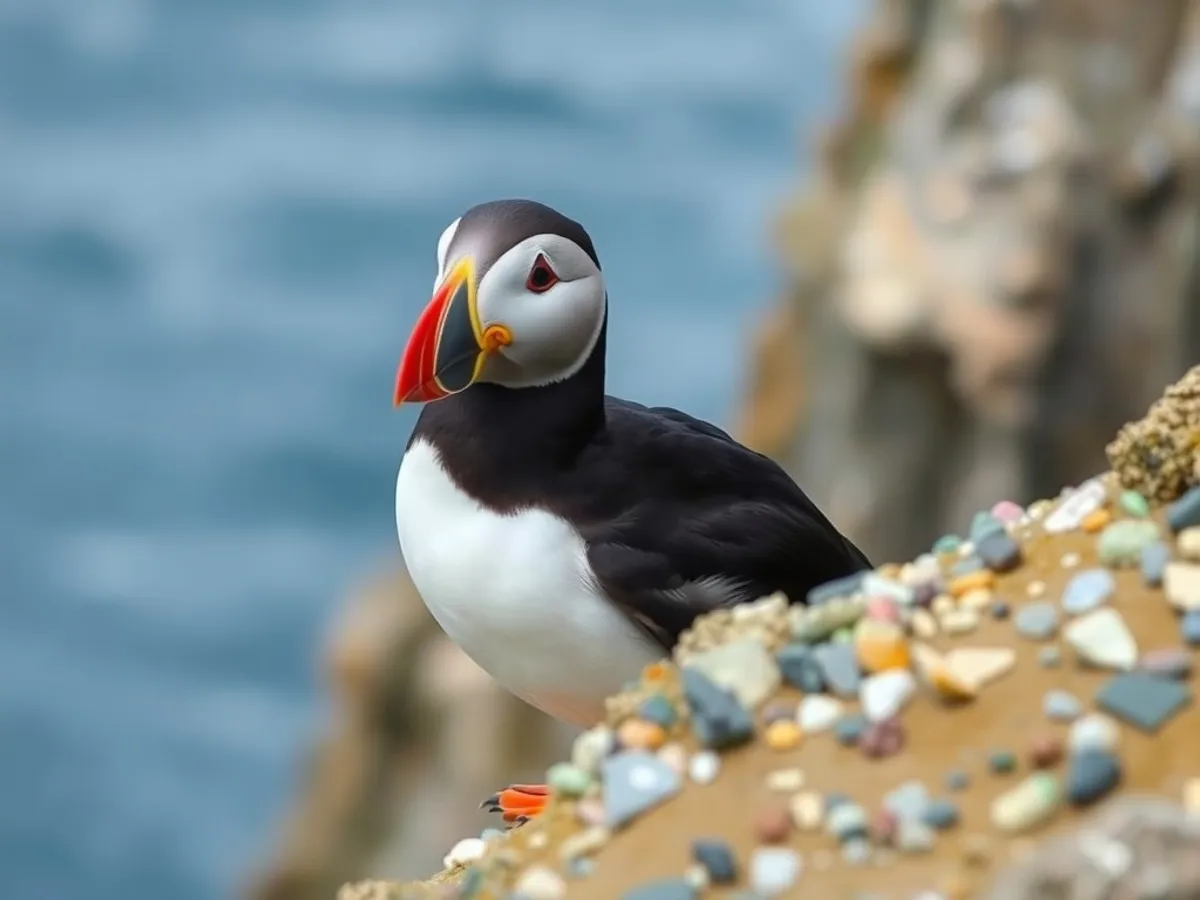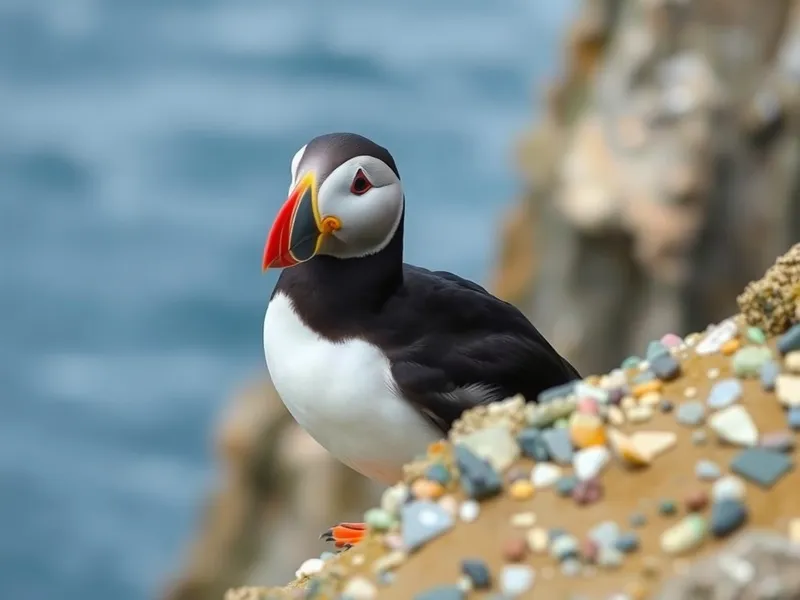
Tufted Puffin
Fratercula cirrhata

Meet the Tufted Puffin
The Tufted Puffin is a striking seabird recognized by its bold white facial tufts and bright orange bill, especially prominent during the breeding season. This medium-sized puffin inhabits the rocky cliffs and islands of the North Pacific Ocean, nesting in colonies and spending much of its life at sea. Renowned for its remarkable diving abilities, the Tufted Puffin can capture fish at significant depths. Its populations are stable in remote areas, though it faces localized threats from habitat disturbance and marine pollution.
Classification
Bird
Habitat
Rocky coastal cliffs and offshore islands
Diet
Carnivore
Lifespan
15-25 years
Conservation
Least Concern
Weight
750-800 grams
📖Fascinating Facts
Multiple Prey Carriers
Tufted Puffins can carry several fish at once in their bills, sometimes up to 20, allowing them to efficiently feed their young.
Burrow Nesters
These birds dig burrows into grassy or rocky soil on coastal cliffs and islands to protect their single egg from predators and harsh weather.
Seasonal Plumes
The characteristic golden head tufts are only present during the breeding season, making Tufted Puffins particularly eye-catching in summer.
📋Detailed Description
The Tufted Puffin (Fratercula cirrhata) is a robust, medium-sized seabird, typically measuring 35–40 cm (14–16 in) in length with a wingspan of 63–75 cm (25–30 in), and weighing between 600–800 grams (1.3–1.8 lbs). Adults are unmistakable during the breeding season, sporting a thick, laterally compressed orange-red bill, stark white facial patches, and long, golden-yellow tufts extending backward from each side of the head. Outside the breeding season, their bill dulls and the facial tufts are shed, making them less conspicuous. Their plumage is predominantly black, with a slightly paler underwing. Adapted for life at sea, their wings are short and strong, enabling powerful underwater propulsion during dives. Tufted Puffins are highly pelagic outside the breeding season, spending months at sea and only returning to land to breed. Their legs and feet are bright orange and set far back on the body, facilitating efficient swimming but resulting in a clumsy gait on land. The species is known for its colonial nesting habits, often forming dense aggregations on steep, grassy slopes or rocky islands. Their vocalizations are generally low, guttural growls and grunts, especially at breeding colonies. The Tufted Puffin's lifespan in the wild is estimated at 15–20 years, with some individuals known to reach over 20 years.
💡 Did you know?
Unlike many other seabirds, Tufted Puffins can carry multiple fish crosswise in their bills at once, thanks to a unique hinge in their jaws.
🔬Research & Sources
Wikipedia Summary
The tufted puffin, also known as crested puffin, is a relatively abundant medium-sized pelagic seabird in the auk family (Alcidae) found throughout the North Pacific Ocean. It is one of three species of puffin that make up the genus Fratercula and is easily recognizable by its thick red bill and yellow tufts.
Last Modified: 5/17/2025
🎭Behavior & Social Structure
Tufted Puffins are diurnal, with peak activity occurring during daylight hours, especially at breeding colonies. At sea, they are solitary or found in small, loose groups, but become highly social during the breeding season, forming large, noisy colonies. They are accomplished divers, using their wings to 'fly' underwater, often reaching depths of 20–60 meters (65–200 feet) and remaining submerged for up to 30 seconds. Their diet consists mainly of small pelagic fish (such as sand lance, capelin, and herring), but also includes squid, crustaceans, and occasionally zooplankton. Puffins capture prey by pursuit diving, often carrying multiple fish crosswise in their bills thanks to specialized spines on the palate and tongue. Social interactions at colonies include ritualized billing, vocal displays, and aggressive posturing to defend nest burrows. Puffins are territorial around their burrow entrances but generally tolerant of neighbors. Outside the breeding season, they are largely silent and spend nearly all their time at sea, resting on the water and foraging.
👶Reproduction & Life Cycle
Tufted Puffins are monogamous, with pairs often reuniting at the same nesting site year after year. The breeding season begins in late spring (May–June), varying with latitude. They excavate burrows up to 1.5–2 meters (5–6.5 feet) long in soft soil or occupy natural crevices in rocky areas. A single white egg is laid per season, with both parents sharing incubation duties for 40–45 days. After hatching, the chick (known as a 'puffling') is brooded and fed by both parents, receiving regurgitated fish several times daily. The chick remains in the burrow for 40–55 days, during which it rapidly gains weight. Fledging occurs at night, with the young bird leaving the burrow and heading directly to sea, where it becomes independent. Tufted Puffins do not breed until they are 3–5 years old, and breeding success is highly dependent on food availability and colony disturbance.
🛡️Adaptations & Survival
Tufted Puffins exhibit a suite of adaptations for their marine lifestyle. Their wings are short and rigid, providing powerful thrust underwater, while their dense, waterproof plumage insulates them in cold northern waters. The large, laterally flattened bill is adapted for carrying multiple fish at once, aided by backward-facing spines on the palate and tongue. Their strong, webbed feet enable agile swimming and digging of nesting burrows. The striking breeding plumage and tufts are believed to play a role in mate attraction and species recognition. Their keen vision is adapted for both aerial and underwater environments, allowing them to spot prey at depth. Seasonal changes in bill coloration and facial ornamentation help reduce predation risk outside the breeding season.
🎨Cultural Significance
Tufted Puffins have held cultural importance for indigenous peoples of the North Pacific, who have historically used their feathers and skins for clothing and ceremonial items. The bird's striking appearance has made it a symbol of coastal wilderness and is featured in local art, folklore, and tourism promotion, especially in Alaska and the Russian Far East. In some cultures, puffins are associated with abundance and the sea's bounty. Their charismatic looks and nesting habits have also made them a flagship species for seabird conservation in the North Pacific.
🔬Recent Research & Discoveries
Recent research has focused on the impacts of climate change on Tufted Puffin foraging ecology, with studies revealing shifts in prey composition and foraging range in response to warming ocean temperatures. Stable isotope analysis and GPS tracking have provided insights into their at-sea distribution and migration patterns, showing that some populations undertake extensive post-breeding dispersal. Genetic studies have clarified relationships within the genus Fratercula and highlighted low genetic differentiation across the North Pacific, suggesting high gene flow. Ongoing monitoring at key colonies is tracking population trends and reproductive success, with particular attention to the effects of introduced predators and human disturbance. Notably, mass die-off events linked to anomalous ocean warming ('the Blob') have been documented in the Bering Sea and Gulf of Alaska, raising concerns about future resilience.
🎥Wildlife Videos

Puffin Hunts Fish To Feed Puffling | Blue Planet II | BBC Earth
Taken From Blue Planet II This bold cinematic experience takes viewers on a magical adventure across the greatest, yet least ...
BBC Earth

Cute Baby Puffin Sees World for the First Time! | World Beneath Your Feet | BBC Earth
Underneath the Farne Islands hides an animal more often expected in the water... Taken from World Beneath Your Feet.
BBC Earth

Atlantic Puffins! Documentary. #thehowtoacademy
Dive into the fascinating world of Atlantic puffins in this eye-opening documentary! Uncover the secret lives of these colorful ...
Pristine Planet 4K

Master Predators of the Sea | Land of 10,000 Grizzlies
About National Geographic Wild: National Geographic Wild is a place for all things animals and for animal-lovers alike. Take a ...
Nat Geo Animals

PUFFIN ISLAND
Nestled in the Celtic Sea, the pristine island of Skokholm is witness to one of the greatest wildlife gatherings in Britain every spring ...
Ishan Vaidya

The Tufted Puffins of Destruction Island (Salish Sea Wild)
On a risky mission to the remote, rugged Destruction Island, Team SeaDoc tries to solve the mysteries of the Tufted Puffin in the ...
SeaDoc Society
🌍Habitat Information
The Tufted Puffin typically inhabits Rocky coastal cliffs and offshore islands environments. Tufted Puffins have adapted to their environments with specialized features and behaviors.
Primary Habitat:
Rocky coastal cliffs and offshore islands
More detailed habitat information will be available soon.
🛡️Conservation Status
The Tufted Puffin is currently classified as Least Concern. Conservation efforts are crucial for preserving this species for future generations.
Common Threats:
- 🏠Habitat loss and fragmentation
- 🌡️Climate change impacts
- 🎯Hunting and poaching
- 🏭Human-wildlife conflict
⚠️Threats & Conservation Challenges
While the Tufted Puffin is currently listed as Least Concern by the IUCN, regional populations face several threats. These include introduced predators (such as foxes, rats, and mink) at breeding colonies, which can devastate eggs and chicks. Human disturbance, especially from tourism and coastal development, can lead to breeding failure. Marine pollution, particularly oil spills and plastic ingestion, poses significant risks. Climate change is altering prey availability and oceanographic conditions, potentially impacting breeding success. Bycatch in commercial fisheries and entanglement in fishing gear are additional concerns. In some regions, population declines have been noted, particularly at the southern edge of their range, though northern populations remain stable.
🔬Scientific Classification
Scientific Name
Fratercula cirrhata
Classification Hierarchy
🔍 About Taxonomic Classification
Taxonomic classification is a hierarchical system used by scientists to classify and organize living organisms based on shared characteristics and evolutionary relationships.
The system moves from broad categories (Kingdom) to increasingly specific ones, with each animal's scientific name typically consisting of its Genus and species.
📝Community Notes
Share your observations and insights about the Tufted Puffin with our community of wildlife enthusiasts.
Join Our Community
Sign in to share your observations and connect with fellow wildlife enthusiasts.
Sign In to ContributeNo community notes yet
Be the first to share your observations about the Tufted Puffin!
Explore Tufted Puffin
Select a tab above to learn more about this amazing animal.
📸Photo Gallery
No photos available for this animal yet.
🌟Discover More Wildlife
Continue your journey of discovery with more fascinating animals from our database
